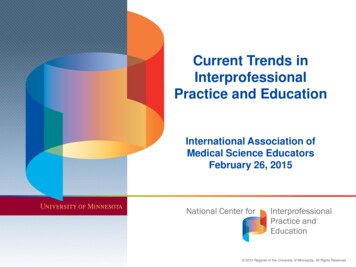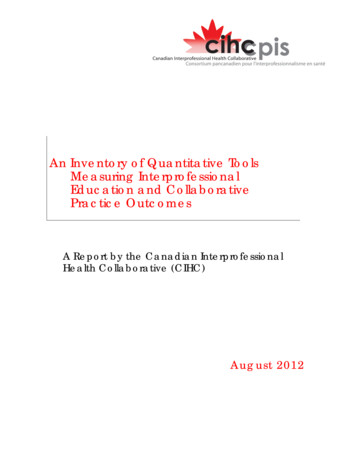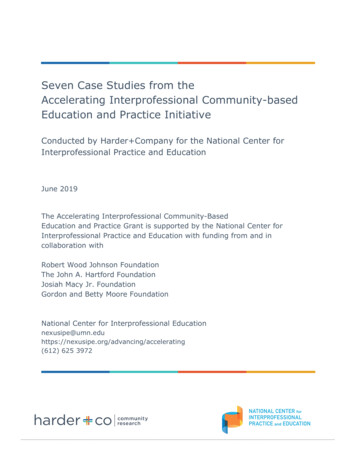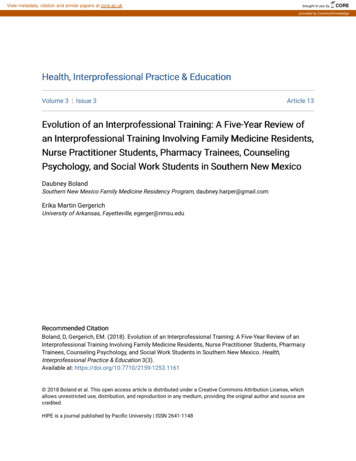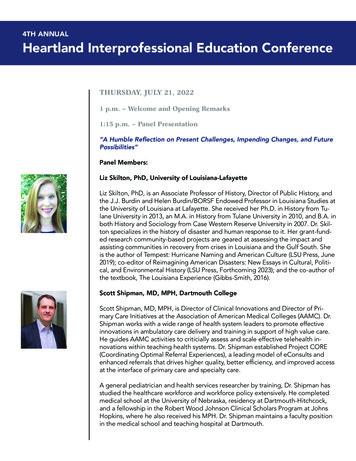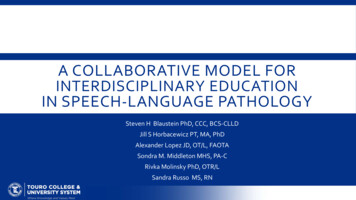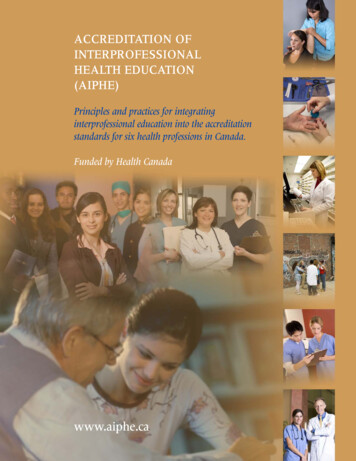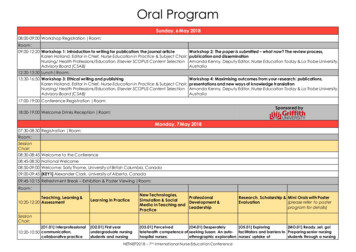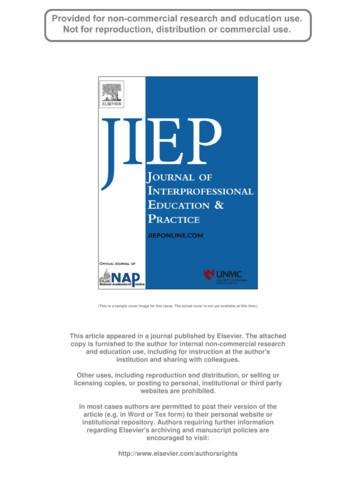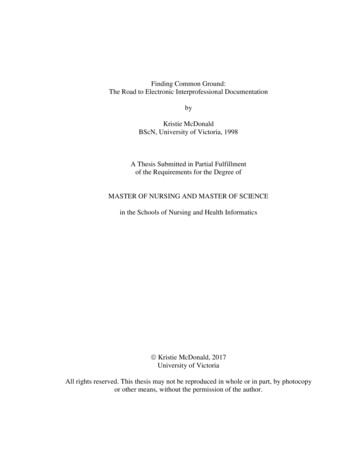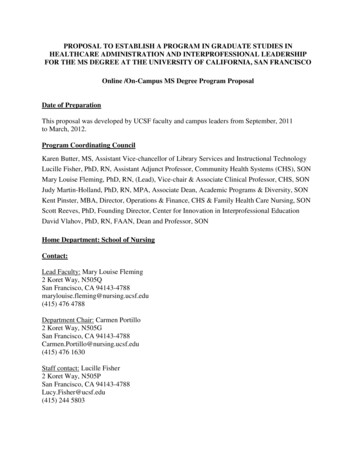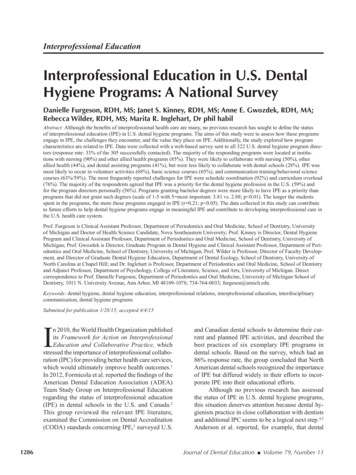
Transcription
Interprofessional EducationInterprofessional Education in U.S. DentalHygiene Programs: A National SurveyDanielle Furgeson, RDH, MS; Janet S. Kinney, RDH, MS; Anne E. Gwozdek, RDH, MA;Rebecca Wilder, RDH, MS; Marita R. Inglehart, Dr phil habilAbstract: Although the benefits of interprofessional health care are many, no previous research has sought to define the statusof interprofessional education (IPE) in U.S. dental hygiene programs. The aims of this study were to assess how these programsengage in IPE, the challenges they encounter, and the value they place on IPE. Additionally, the study explored how programcharacteristics are related to IPE. Data were collected with a web-based survey sent to all 322 U.S. dental hygiene program directors (response rate: 33% of the 305 successfully contacted). The majority of the responding programs were located at institutions with nursing (90%) and other allied health programs (85%). They were likely to collaborate with nursing (50%), otherallied health (44%), and dental assisting programs (41%), but were less likely to collaborate with dental schools (28%). IPE wasmost likely to occur in volunteer activities (68%), basic science courses (65%), and communication training/behavioral sciencecourses (63%/59%). The most frequently reported challenges for IPE were schedule coordination (92%) and curriculum overload(76%). The majority of the respondents agreed that IPE was a priority for the dental hygiene profession in the U.S. (59%) andfor the program directors personally (56%). Programs granting bachelor degrees were more likely to have IPE as a priority thanprograms that did not grant such degrees (scale of 1-5 with 5 most important: 3.81 vs. 2.88; p 0.01). The longer the studentsspent in the programs, the more those programs engaged in IPE (r 0.21; p 0.05). The data collected in this study can contributeto future efforts to help dental hygiene programs engage in meaningful IPE and contribute to developing interprofessional care inthe U.S. health care system.Prof. Furgeson is Clinical Assistant Professor, Department of Periodontics and Oral Medicine, School of Dentistry, Universityof Michigan and Doctor of Health Science Candidate, Nova Southeastern University; Prof. Kinney is Director, Dental HygieneProgram and Clinical Assistant Professor, Department of Periodontics and Oral Medicine, School of Dentistry, University ofMichigan; Prof. Gwozdek is Director, Graduate Program in Dental Hygiene and Clinical Assistant Professor, Department of Periodontics and Oral Medicine, School of Dentistry, University of Michigan; Prof. Wilder is Professor, Director of Faculty Development, and Director of Graduate Dental Hygiene Education, Department of Dental Ecology, School of Dentistry, University ofNorth Carolina at Chapel Hill; and Dr. Inglehart is Professor, Department of Periodontics and Oral Medicine, School of Dentistryand Adjunct Professor, Department of Psychology, College of Literature, Science, and Arts, University of Michigan. Directcorrespondence to Prof. Danielle Furgeson, Department of Periodontics and Oral Medicine, University of Michigan School ofDentistry, 1011 N. University Avenue, Ann Arbor, MI 48109-1078; 734-764-0033; furgeson@umich.edu.Keywords: dental hygiene, dental hygiene education, interprofessional relations, interprofessional education, interdisciplinarycommunication, dental hygiene programsSubmitted for publication 1/28/15; accepted 4/4/15In 2010, the World Health Organization publishedits Framework for Action on InterprofessionalEducation and Collaborative Practice, whichstressed the importance of interprofessional collaboration (IPC) for providing better health care services,which would ultimately improve health outcomes.1In 2012, Formicola et al. reported the findings of theAmerican Dental Education Association (ADEA)Team Study Group on Interprofessional Educationregarding the status of interprofessional education(IPE) in dental schools in the U.S. and Canada.2This group reviewed the relevant IPE literature,examined the Commission on Dental Accreditation(CODA) standards concerning IPE,3 surveyed U.S.1286and Canadian dental schools to determine their current and planned IPE activities, and described thebest practices of six exemplary IPE programs indental schools. Based on the survey, which had an86% response rate, the group concluded that NorthAmerican dental schools recognized the importanceof IPE but differed widely in their efforts to incorporate IPE into their educational efforts.Although no previous research has assessedthe status of IPE in U.S. dental hygiene programs,this situation deserves attention because dental hygienists practice in close collaboration with dentistsand additional IPC seems to be a logical next step.4,5Anderson et al. reported, for example, that dentalJournal of Dental Education Volume 79, Number 11
hygiene educators and their programs are well placedto collaborate with other allied health professions,such as nursing and physician assistants, to includeoral health in the primary care setting.6 In addition,dental hygienists have increasingly more opportunities for IPC in community centers and other healthcare institutions due to changes in licensure.7 Forming IPE partnerships has been found to help buildopportunities to become part of IPC teams. Thesepartnerships have been identified as one way tocontribute to a paradigm shift in dental and dentalhygiene education.8Dental hygiene is well placed to be a keyplayer in IPE. While IPE is not explicitly mentionedin the accreditation standards for dental hygieneeducation, these standards require graduates to becompetent in communicating with other health careproviders.9 Specifically, Standard 2-15 requiresgraduates to be competent in both interpersonal andcommunication skills for collaboration with otherhealth care disciplines for comprehensive patientcare. Other standards such as 2-13a and 2-13f require the collection of all necessary patient healthinformation, which often requires collaborationwith other health care providers, and competence inproblem-solving strategies related to comprehensivepatient care. Additionally, dental hygiene practiceis being incorporated into more nontraditional settings such as long-term care facilities, hospitals, andpublic health venues. Therefore, the dental hygienecurriculum must include IPE experiences that willprepare students to serve in those situations thatcall for IPC.8A question of interest is in which specific IPEcollaborations dental hygiene programs are currentlyengaged. The study of IPE efforts in dental schoolsaddressed this question by first asking respondents toindicate which allied health programs were present attheir institutions and then with which programs thedental schools actually engaged in IPE efforts.2 Thatstudy found that 82% of responding dental schoolshad a medical and a nursing school on campus; 65% apharmacy school, physical therapy program, and psychology department; and only 50% a dental hygieneprogram. In response to the question about programswith which they were engaged in IPE, 63% reportedthat they collaborated with their medical school and58% engaged in IPE with a dental hygiene program.Fewer than half of the schools had IPE activitieswith other disciplines. The first aim of our studywas therefore to collect information about whichhealth professions programs are present in the dentalNovember 2015 Journal of Dental Educationhygiene programs’ institutions as well as with whichdisciplines the programs actively engage in IPE.In addition, it is critical to understand howIPE is concretely placed in the didactic and clinicalcontext of dental hygiene education. The resultsfrom the dental school survey showed that the highest percentage of IPE activities were joint volunteeractivities (66%), followed by clinical activities(60%) and service-learning projects (52%).2 All otherIPE activities such as joint basic science courses(32%), communication training (31%), and ethicscourses (15%) were reported by fewer than half ofthe responding dental schools. The second aim of ourstudy was therefore to determine in which tangibleIPE experiences dental hygiene programs engageand, specifically, whether these activities are alignedwith CODA standards 2-13a, 2-13f, and 2-15, whichindirectly refer to IPC.9When designing IPE, careful planning is crucial.10,11 For example, establishing a positive interprofessional team environment and developing anappropriate interprofessional team culture should bepart of curriculum planning for IPE.11 Dental hygieneeducators must ensure that any IPE curriculum development is not only workable within dental hygiene,but also within the collaborating disciplines.10-12 It istherefore not surprising that establishing IPE facessevere challenges. The dental school IPE surveyidentified three categories of challenges.2 The firstcategory consisted of organizational issues suchas finding a location and time in the curriculum;second, person-related challenges were found, suchas problems with adequate leadership support andadequately trained faculty; the third category wascomprised of cultural and philosophical challenges.Other studies have found that a lack of support from institutional administration at the deanlevel was a severe challenge that weakened anyIPE initiative.10-12 Additional reported barriers to theintegration of IPE have been that major curriculumrevisions were needed and that faculty buy-in forthese changes was necessary.11,12 Lack of facultypreparation, IPE understanding, and calibration hasalso been reported to be a significant barrier to successfully integrating IPE.13 One final reported challenge, reported by Ateah et al., relates to the fact thata previous lack of engagement with other disciplineshas frequently resulted in misconceptions about otherhealth professions.14 These misconceptions can createhierarchies that become difficult barriers to surmountwhen developing IPE and engaging in IPC in clinicalsettings. Ateah et al. showed, for example, that dental1287
hygienists were perceived to be lacking in academicability, decision making, and leadership skills andthat these negative perceptions had significantlyimproved after IPE.Based on these research findings in otherdisciplines, another aim of our study was to assessthe challenges that dental hygiene program directors encounter when implementing IPE, as well asexploring whether certain program characteristicssuch as program length or type of degree conferredaffect the way programs engage in IPE. In summary,the aims of this study were to assess how U.S. dentalhygiene programs engage in IPE, what challengesthey encounter, the value they place on IPE, and howprogram characteristics are related to IPE.MethodsThis study was determined to be exempt fromoversight by the Institutional Review Board for theBehavioral and Health Sciences at the University ofMichigan (HUM#00083956). The email addresses of322 directors of entry-level dental hygiene programswere obtained from the dental hygiene education program page on the American Dental Hygienists’ Association (ADHA) website. A first recruitment emailwas sent in February 2014 to each of the programdirectors individually. This email informed themabout the study and provided a link to an anonymousweb-based survey. Two follow-up emails were sent.The survey was a revised version of the surveyused by the ADEA Team Study Group on Interprofessional Education to investigate IPE activities inU.S. and Canadian dental schools.2 Permission toadapt this survey for use with U.S. dental hygieneprograms was obtained from Dr. Allan J. Formicola,head of that study group. We made two revisions tothe survey. First, we changed the questions concerning the program characteristics to be more genuinelyrelevant for dental hygiene programs. Second, wereplaced the dental accreditation standards with thedental hygiene accreditation standards that wererelevant to IPE.Part I of our survey inquired about dentalhygiene program characteristics, including theprogram’s educational setting, degree/s granted,number of annual graduates, and length of time fordegree completion. Part II focused on identifyingwhich potential IPE collaborations between dentalhygiene programs and other disciplines were possible and which actually existed. Another question1288asked in which specific IPE activities the programswere engaged such as whether they had joint ethics,basic science, or behavioral science courses. Part IIIinquired whether IPE activities were related to theCODA dental hygiene standards that have an impliedconnection with IPE.9 Those questions asked whichIPE-related activities the programs included in theirefforts to demonstrate compliance with the spirit ofthe relevant standards. In addition, the program directors were asked to describe any plans to include IPEactivities to comply with the intent of these standardsin the future and to assess the outcomes of their IPEengagement. The last part of the survey asked aboutchallenges encountered by the programs when tryingto engage in IPE activities.The data were downloaded from the website asan Excel file and imported into SPSS (Version 20).Descriptive statistics such as frequencies, percentages, means, standard deviations, and ranges werecomputed to provide an overview of the closed-endedanswers. The answers to the open-ended questionswere transcribed and thematically coded by two ofthe authors. Step 1 was to determine coding categories for each open-ended question that were mutuallyexclusive and comprehensive. Step 2 was to group theopen-ended responses under these major categories.Coding discrepancies were resolved by discussionuntil agreement was achieved. The frequencies ofresponses in each category were then determined.Independent sample t-tests were used to determineif the responses of programs that offered baccalaureate degrees differed from those that did not. Pearsoncorrelation coefficients were used to determine ifthere was a relationship between the responses andprogram length or number of graduates per year. Thelevel of statistical significance was set at p 0.05.ResultsOf the first emails sent to 322 program directors, 17 were undeliverable, and 56 program directorscompleted the survey. In April 2014, a first follow-up,individualized email was sent, asking those who hadnot yet responded to do so. This email resulted in 28additional responses. On May 8, a second follow-upgroup email was sent through the ADEA Council onDental Hygiene Program Directors’ listserv. Thisemail informed the recipients that 84 programs hadresponded and asked nonrespondents for their participation; 18 additional surveys were received inresponse to this second follow-up email. Ultimately,Journal of Dental Education Volume 79, Number 11
of the 305 programs successfully contacted, a total of102 submitted a survey, but some skipped individualquestions and one respondent skipped all of Part II.The overall response rate was 33%.Of the 102 respondents, 49% were located ata community or junior college, 17% at a school ofallied health sciences, 14% at a dental school, 13%at a university or four-year college, and 6% at atechnical college. An associate degree was offeredby 79% of the programs, a baccalaureate degree by29%, and a diploma or certificate by 3%. The numberof students who graduate per year ranged between 10and 60 (Mean 25; SD 10.52). The length of the programs ranged between 18 and 48 months (Mean 26months; SD 6.04).Table 1 provides an overview of other healthrelated programs at the respondents’ institutions. Themajority of programs had a nursing school (90%),another allied health program (85%), and a psychology department (61%) on their campus. While 41%had a dental assisting program, only 20% had a dentalschool and 18% a dental specialty graduate program.When asked with which of these programs they collaborated, the most commonly named program wasnursing (50%), followed by other allied health programs (44%) and dental assisting programs (41%).In addition, 28% collaborated with a dental school,18% with a dental specialty program, and 11% with amedical school. Very few programs collaborated witha psychology department or social work program.Table 2 provides an overview of joint programactivities. The highest percentage of joint effortsinvolved volunteer activities (68%), followed bybasic science courses (65%), communication training (63%), and behavioral science courses (59%).Joint community-based clinical education andservice-learning projects occurred in about half ofthe programs (48% and 50%, respectively), whilejoint efforts in ethics classes were reported by only8% of the respondents.Three questions concerning IPE-related challenges were included in the survey. The first question asked “How challenging is it for your programto engage in IPE?” Response options were on afive-point scale from 1 not at all to 5 very challenging. The average response was 3.62 (SD 0.95;range 2-5), indicating a high level of encounteredchallenges. Second, the respondents answered thequestion “Which challenges related to IPE do youcurrently encounter?” by checking which of the ninelisted challenges they had experienced (Table 3). Themost frequently checked challenges were scheduleNovember 2015 Journal of Dental EducationTable 1. Health professions programs at dental hygieneprograms’ institutions and those with which the programs collaborate for IPE activities, by percentage oftotal respondents to this part (n 101)ProgramYes: AtYes: HaveInstitution CollaborationDental schoolDental specialty graduate programDental therapy programDental assisting programMedical schoolPhysician assistant programNursing schoolPharmacy programPhysical therapy programOther allied health programPsychology departmentSocial work programOther:Physical therapy assistantRadiology 4%18%4%8%[Author: is this n correct (based on 102 respondentsminus the one that didn’t answer this part)? Also, how is itpossible for some items to have higher % of collaborationthan of program existence?]Table 2. Activities at dental hygiene programs thatallow interactions between students from differentdisciplines, by percentage of total respondents (n 102)ActivityVolunteer activitiesBasic science courseCommunication trainingBehavioral science coursesService-learning projectsCommunity-based clinical educationClinical activitiesStandardized patient programsEthics classesYes: Have Activity68%65%63%59%50%48%43%25%8%coordination (92%), curriculum overload (76%),calibration of faculty (48%), and having meaningfulinteractions with students (42%). Fewer respondentsreported that a lack of space (33%) and evaluatingoutcomes (32%) were a problem, and very few chosea lack of educational resources (14%) and supportfrom administration (16%) as challenges. Third, theopen-ended question “Which challenges related toIPE do you expect to encounter in the future?” wasasked. Of the 13 responses to this question, six citedscheduling issues and logistic problems, three a lackof other programs to collaborate with, and two a1289
lack of administrative support from their institutionas challenges.Table 4 shows the respondents’ perspectives onthe value of IPE. They were first asked to rate howimportant IPE is as one of the top five priorities forthem personally, for their academic institution, andfor the dental hygiene profession in the U.S., usinga scale from 1 not at all important to 5 extremelyimportant. The majority of respondents indicatedthat IPE was very (34%) or extremely important(24%) for themselves, but fewer thought that it wasTable 3. Challenges related to interprofessional education that dental hygiene programs experience, bypercentage of total respondents (n 102)ChallengeSchedule coordinationCurriculum overloadCalibrated facultyOpportunities for meaningful studentinteractionsRoom spaceEvaluating outcomesPartnership opportunities within homeinstitutionSupport from administrationEducational resourcesYes: Face Challenge92%76%48%42%33%32%26%16%14%very (22%) or extremely important (18%) for theirinstitution. However, the majority responded thatIPE was very (28%) or extremely important (29%)for the dental hygiene profession in the U.S. Anopen-ended question “Please explain your answerchoices in the Comments section” followed thesethree closed-ended questions. Of the 102 programdirectors, 21 provided an answer. Six respondentsthought that IPE is important to universities/colleges/educational programs, and four noted that itwas critical for the dental hygiene profession. Threepointed to the importance of communication amonghealth care providers, and two described a need forcomprehensive patient care.In addition, the respondents were asked howimportant it was that their graduates were competentin the four interprofessional collaboration areas included in the study of dental schools in the U.S. andCanada.2 These four competencies were “workingwith individuals of other professions to maintain aclimate of mutual respect and shared values,” “usingthe knowledge of one’s own role and those of otherprofessions to appropriately assess and address thehealth care needs of the patients and populationsserved,” “communicating with patients, families,communities, and other health professionals in aresponsive and responsible manner that supportsa team approach to the maintenance of health andTable 4. Dental hygiene program directors’ perspectives on interprofessional education (IPE) as a priority and graduates’ competence, by number and percentage of respondents to each itemPriorities/Competence1 5Not at AllExtremelyImportant234ImportantIPE is one of the top five priorities for:Me as a dental hygiene program director. (n 98)2103033232%10%29%34%24%My academic institution. (n 96)8252521178%26%26%22%18%The dental hygiene profession in the United States. (n 91)172429301%7%24%28%29%Graduates must be competent to:Work with individuals of other professions to maintain a01101669climate of mutual respect and shared values. (n 96)1%10%16%72%Use the knowledge of one’s own role and those of other0192164professions to appropriately assess and address the health1%10%22%67%care needs of the patients and populations served. (n 95)Communicate with patients, families, communities, and0171671other health professionals in a responsive and responsible1%7%17%75%manner that supports a team approach to the maintenanceof health and treatment of disease. (n 95)Apply relationship-building values and the principles of0282165team dynamics to perform effectively in different team2%8%22%68%roles to plan and deliver patient-/population-centered carethat is safe, timely, efficient, effective, and equitable. (n .7104.650.6654.550.738[Author: I’ve inserted a response number for each item based on totaling actual responses in the columns; okay? Pleasedoublecheck those totals plus the percentages.]1290Journal of Dental Education Volume 79, Number 11
treatment of disease,” and “applying relationshipbuilding values and the principles of team dynamicsto perform effectively in different team roles to planand deliver patient-/population-centered care that issafe, timely, efficient, effective, and equitable.” Theaverage responses to these questions indicated anexceptionally high level of perceived importance ofthese competencies (Table 4).In addition to providing an overview of theresponses, it is also worthwhile to analyze whetherprogram characteristics affected the responses.Table 5 shows the average responses of programsthat confer vs. do not confer a baccalaureate degree.The programs with baccalaureate degrees had onaverage more health programs in their institutions(6.40 vs. 4.19; p 0.001) and collaborated withmore programs (3.40 vs. 2.21; p 0.005) than nonbaccalaureate-granting programs. In addition, thebaccalaureate-granting programs reported that IPEwas more important for their institutions than thenon-baccalaureate-granting programs (on a fivepoint scale with 1 lowest importance: 3.81 vs. 2.88;p 0.001). However, the two sets of programs didnot differ in average numbers of IPE activities, IPErelated challenges encountered, or the importancethey assigned to IPE regarding CODA standardrelated activities.The relationships between program length andnumber of graduates per year and the IPE-relatedresponses were also analyzed. The longer the time todegree completion, the higher the sum of activities(r 0.21; p 0.03) and the higher the priority of IPEfor their academic institutions (r 0.34; p 0.001). Thenumber of graduates per year was correlated withthe sum of programs on campus (r 0.28; p 0.005),the sum of programs with whom they had IPE collaborations (r 0.29; p 0.004), the priority of IPEfor the program directors (r 0.24; p 0.05), and howTable 5. Differences in interprofessional education (IPE)-related responses of programs that grant vs. do not grant abaccalaureate degree and correlations between these responses and program length and number of graduates per yearIPE-Related ResponsesBaccalaureateDegree: NoN 72Sum of programs on campusaSum of programs with which collaborations take placeaProportion of programs with collaborations on campusb4.192.2157.71BaccalaureateDegree: YesN 30p-value6.403.4071.68 0.0010.0050.277LengthofProgramNumber ofGraduatesper Year0.190.100.010.28**0.29**0.11Educational activitiesSum of activitiesc4.394.570.7130.21*Sum of clinical activitiesd1.972.370.2080.15Sum of classroom-based d challengesOverall degree of challengef3.663.540.582-0.11Sum of challengesg3.634.130.1840.080.000.13IPE as priorityhFor dental hygiene program director3.653.740.7040.040.24*For academic institution2.883.810.0010.34***0.15For dental hygiene t in other professions4.574.670.5370.070.23*Competent in own role4.544.590.766-0.010.14Communication with stakeholders4.664.630.8330.080.06Competent in relationship-building4.554.560.9770.000.04Answers ranged from 0 to 13 other programs on the dental hygiene programs’ campus (see Table 1 for programs).This index provides the percentage of collaborations based on number of programs available/on campus.cThis index ranged from 0 to 9 joint IPE activities in which programs were engaged (see Table 2 for activities).dThis index ranged from 0 to 4 joint clinical IPE activities in which programs were engaged. Activities were joint volunteer activities,service-learning projects, community-based clinical education, and clinical activities.eThis index ranged from 0 to 5 joint classroom-based IPE activities in which programs were engaged. Activities were joint basic sciencecourses, communication training, behavioral science courses, standardized patient programs, and ethics classes.fOverall degree of challenge was assessed with the question “How challenging was it for you to engage in IPE?” Response optionsranged from 1 not at all to 5 very challenging.gThis index ranged from 0 to 9 (see Table 3 for list of challenges).hResponse options ranged from 1 not at all to 5 extremely important.ab[Author: need key to asterisks]November 2015 Journal of Dental Education1291
much the directors valued that their students werecompetent to collaborate with providers from otherprofessions (r 0.23; p 0.05).DiscussionThe Affordable Care Act accelerated a changein the health care paradigm that affects the provisionof health care. The focus is on increased access tocare, coordination of care, and connecting patientsto needed health resources in their communities inthe pursuit of improved health outcomes.15,16 Thisparadigm shift makes interprofessional care integralto providing health care. IPE prepares future careproviders for this new situation and helps them todevelop a better understanding of their own role andthe role of providers from other disciplines.17 Curranet al. found that the maximum impact of IPE can beachieved when students are exposed to IPE both earlyand frequently during the course of their studies.18Given this situation, it is important for educators todevelop a better understanding of the status of IPEin U.S. dental hygiene programs.The first aim of this study was to determinehow many other health professions programs werelocated in the same institutions as dental hygieneprograms and with how many of these disciplines thedental hygiene programs had joint IPE activities. Acomparison of the results of this study of dental hygiene programs with the findings regarding U.S. andCanadian dental schools2 showed that both types ofprograms were very likely to have a nursing school ontheir campus (90% vs. 82%) and to collaborate withthat program (50% vs. 47%). However, campuseswith a dental hygiene program were less likely tohave a dental school (20% vs. 50%), medical school(21% vs. 82%), pharmacy school (25% vs. 65%),or physical therapy program (32% vs. 65%) thanthe dental schools. This finding is likely due to thefact that 49% of the dental hygiene programs werelocated at a community or junior college and 6% ata technical college, which are institutions that do notusually have a dental or medical school. This fact alsoexplains why 58% of the dental schools reported jointIPE with dental hygiene programs, while only 38%of the dental hygiene programs reported having jointIPE activities with dental schools.Concerning the joint IPE activities in whichthese dental hygiene programs and dental schoolsengaged, the majority of both types of programsreported joint volunteer activities (68% vs. 66%) and1292service-learning projects (50% vs. 52%). This findingraises the question of whether these types of activitieswere voluntary and not a required part of the core curricula. Future research should assess in more detailwhich specific joint activities are required and whichare merely self
Journal of Dental Education 1287 hygiene programs' institutions as well as with which disciplines the programs actively engage in IPE. In addition, it is critical to understand how IPE is concretely placed in the didactic and clinical context of dental hygiene education. The results from the dental school survey showed that the high-
